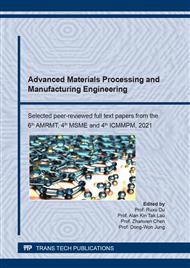[1]
A.T. Egbewande, R.A. Buckson, O.A. Ojo. Analysis of laser beam weldability of Inconel 738 superalloy. Materials Characterization, 61(5)(2010),569-574.
DOI: 10.1016/j.matchar.2010.02.016
Google Scholar
[2]
M.A, Gonzalex, D.I. Martines, A, Perez. Microstructural response of heat-affected zone cracking of prewelding heat-treated Inconel 939 superalloy. Materials Characterization, 62(12)(2011),116- 1123.
DOI: 10.1016/j.matchar.2011.09.006
Google Scholar
[3]
M. Montazeri, F.M. Ghaini. The liquation cracking behavior of IN738LC superalloy during low power Nd:YAG pulsed laser welding. Materials Characterization, 67(2012),65-73.
DOI: 10.1016/j.matchar.2012.02.019
Google Scholar
[4]
Amal Khabouchi, Pascal Ventura, Nicolas Leymarie. Crystallographic texture and velocities of ultrasonic waves in a Ni-based superalloy manufactured by laser powder bed fusion. Materials Characterization, 169(2020),110607.
DOI: 10.1016/j.matchar.2020.110607
Google Scholar
[5]
Y. Tian, J.A. Muniz-Lerma. Nickel-based superalloy microstructure obtained by pulsed laser power bed fusion. Materials Characterization, 131(2017),306-315.
DOI: 10.1016/j.matchar.2017.07.024
Google Scholar
[6]
Yachao Wang, Jing Shi. Developing very strong texture in a nickel-based superalloy by selective laser melting with an ultra-high power and flat-top laser beam. Materials Characterization, 165 (2020),110372.
DOI: 10.1016/j.matchar.2020.110372
Google Scholar
[7]
Ali Rezaei, Ahmad Rezaeian, Ahmad Kermanpur. Microstructural and mechanical anisotropy of selective laser melted IN718 superalloy at room and high temperatures using small punch test. Materials Characterization, 162(2020),110200.
DOI: 10.1016/j.matchar.2020.110200
Google Scholar
[8]
V.D. Divya, R. Munoz Moreno. Microstructure of selective laser melted CM247LC nickel-based superalloy and its evolution through heat treatment. Materials Characterization,114(2016),62-74.
DOI: 10.1016/j.matchar.2016.02.004
Google Scholar
[9]
J.J. Marattukalam, Dennis Karlsson. The effect of laser scanning strategies on texture, mechanical properties and site-specific grain orientation in selective laser melted 316 L SS. Materials & Design, 193(2020),108852.
DOI: 10.1016/j.matdes.2020.108852
Google Scholar
[10]
Hao Chen, Guosheng Huang, Yuanyuan Lu. Epitaxial laser deposition of single crystal Ni-based superalloy: variation of stray grains. Materials Characterization, 158(2019),109982.
DOI: 10.1016/j.matchar.2019.109982
Google Scholar
[11]
Xinbao Zhao, Lin Liu. Microstructure development of different orientated nickel-based single- crystal superalloy in directional solidification. Materials Characterization, 61(1)(2010),7-12.
DOI: 10.1016/j.matchar.2009.09.016
Google Scholar
[12]
Yi Tan, Xiaogang You. Microstructure and deformation behavior of nickel-based superalloy Inconel 740 prepared by electron beam melting. Materials Characterization, 114(2016),267-276.
DOI: 10.1016/j.matchar.2016.03.009
Google Scholar
[13]
L.O. Osoba, R.G. Ding, O.A. Ojo. Microstrctural analysis of laser weld fusion zone in Haynes 282 superalloy. Materials Characterization, 65(2012),93-99.
DOI: 10.1016/j.matchar.2011.12.009
Google Scholar
[14]
Chunlei Qiu, Haoxiu Chen, Qi Liu. On the solidification behavior and cracking origin of a nickel-based superalloy during selective laser melting. Materials Characterization,148(2019),330- 344.
DOI: 10.1016/j.matchar.2018.12.032
Google Scholar
[15]
C.L. Qiu, P. Andrews. On the formation of irregular-shaped gamma-prime and serrated grain boundaries in a nickel-based superalloy during continuous cooling. Materials Characterization, 76(2013),28-34.
DOI: 10.1016/j.matchar.2012.11.012
Google Scholar
[16]
Zhiguo Gao, O.A. Ojo. Modeling analysis of laser-arc hybrid welding single-crystal nickel- based superalloys. Acta Materialia, 60(2012),3153-3167.
DOI: 10.1016/j.actamat.2012.02.021
Google Scholar
[17]
Pulin Nie, O.A. Ojo, Zhuguo Li. Numerical modeling of microstructure evolution during laser additive manufacturing of a nickel-based superalloy. Acta Materialia, 77(2014),85-95.
DOI: 10.1016/j.actamat.2014.05.039
Google Scholar
[18]
H.N. Moosavy, M. R. Aboutalebi. Microstructural, mechanical and weldability assessments of dissimilar welds between γʹ- and γʺ-strengthen nickel-based superalloys. Materials Characterization, 82(2013),41-49.
DOI: 10.1016/j.matchar.2013.04.018
Google Scholar
[19]
K.Y. Shin, J.W. Lee, J.M. Han. Transition of creep damage region in dissimilar welds between Inconel 740H Ni-based superalloy and P92 ferritic/martensitic steel. Materials Characterization, 139 (2018),144-152.
DOI: 10.1016/j.matchar.2018.02.039
Google Scholar
[20]
A. Ghoneim, O.A. Ojo. Microstructure and mechanical response of liquid phase joint in Haynes 282 superalloy. Material Characterization, 62(1)(2011),1-7.
DOI: 10.1016/j.matchar.2010.09.011
Google Scholar
[21]
Xianqiang Fan, Zhipeng Guo, Xiaofeng Wang. Morphology evolution of precipitates in a powder metallurgy Ni-based superalloy. Materials Characterization, 139(2018),382-389.
DOI: 10.1016/j.matchar.2018.02.038
Google Scholar
[22]
M.T. Jovanovica, Z. Miskovica, B. Lukica. Microstructure and stress-rupture life of polycrystal, directional solidified and single crystal castings of nickel-based IN939 superalloys. Materials Characterization, 40(4-5)(1998),261-268.
DOI: 10.1016/s1044-5803(98)00013-8
Google Scholar
[23]
Yahui Liu, Maodong Kang, Yun Wu. Effects of microporosity and precipitates on the cracking behavior in polycrystalline superalloy Inconel 718. Materials Characterization,132(2017), 175-186.
DOI: 10.1016/j.matchar.2017.08.012
Google Scholar


